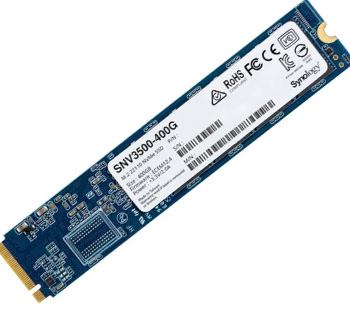Tip #1081: Improve the Responsiveness of a Server
… for Codecs & Media
Tip #1081: Improve the Responsiveness of a Server
Larry Jordan – LarryJordan.com
An NVMe SSD cache card can speed file directory operations and make a server more responsive.


I’ve spent a lot of time this week thinking about how to improve the speed and responsiveness of my storage. Here’s a relatively inexpensive way to improve the responsiveness of a server, especially for smaller workgroups. When it comes to storage there are three elements we can adjust:
- Storage capacity – measured in gigabytes – is how much the device holds
- Bandwidth – the speed it transfers data to and from the computer
- Responsiveness – how fast it responds to requests for data
Looking at these in more detail:
- Capacity – measured in terabytes – we are all familiar with. From experience, we know that we can’t have too much capacity. It seems that hard disks are either empty or full.
- Bandwidth – measured in MB/second – is how fast we can move data from one device to another.
- Responsiveness – measured in milliseconds – is how fast a storage device responds to a request for data.
Most older people celebrate a birthday with a nice dinner. Me? I upgraded my server. I have a Synology DS 1517+ that’s around 3 years old. I connect to it using 1 Gb Ethernet from a variety of different computers.
One of the problems with my storage is that, because my network only consists of 2-3 users, the server is not heavily used. Which means that a lot of the time the drives stop spinning, or spin slower, to save energy because there’s nothing happening across the network.
This means that when I access a server volume from my Mac, it takes several seconds for it to wake up and display a file directory or open a file.
Most of the time, while annoying, this isn’t a big problem. But, all my media is stored on the server, when I’m doing a live webinar this delay drives me nuts.
So, I finally decided to do something about it: I added an SSD card as a cache to the server. SSDs are marketed to database users as a way to improve the responsiveness of I/O operations. And I’m sure it does that. But there are also benefits to media creators in terms of making the server feel much more responsive.
NOTE: The specific hardware that I added were a Synology E10M20-1 Ethernet Adapter, which also holds a Synology SNV3500-400G 400 GB NVMe SSD to accelerate the storage cache. (The card uses an m.2 form factor.)
I was amazed at the difference. Folders pop open almost instantly, even though the disks are not yet up to speed. Navigating is almost as fast as the internal SSD on my computer. While I haven’t, yet, connected the 10 Gbps Ethernet port – though that’s coming – just adding SSD makes a big difference. I don’t feel like I’m waiting on my storage anymore.
NOTE: The SSD does not speed file transfers, but it does make moving around and finding things inside the server much faster.
If you feel that your server is a bit “laggy,” look into adding an SSD card as a cache. It will make your system feel much peppier, even if your server, like mine, still uses spinning disks for storage.


Leave a Reply
Want to join the discussion?Feel free to contribute!